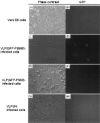Assembly of severe acute respiratory syndrome coronavirus RNA packaging signal into virus-like particles is nucleocapsid dependent
- PMID: 16254320
- PMCID: PMC1280188
- DOI: 10.1128/JVI.79.22.13848-13855.2005
Assembly of severe acute respiratory syndrome coronavirus RNA packaging signal into virus-like particles is nucleocapsid dependent
Abstract
The severe acute respiratory syndrome coronavirus (SARS-CoV) was recently identified as the etiology of SARS. The virus particle consists of four structural proteins: spike (S), small envelope (E), membrane (M), and nucleocapsid (N). Recognition of a specific sequence, termed the packaging signal (PS), by a virus N protein is often the first step in the assembly of viral RNA, but the molecular mechanisms involved in the assembly of SARS-CoV RNA are not clear. In this study, Vero E6 cells were cotransfected with plasmids encoding the four structural proteins of SARS-CoV. This generated virus-like particles (VLPs) of SARS-CoV that can be partially purified on a discontinuous sucrose gradient from the culture medium. The VLPs bearing all four of the structural proteins have a density of about 1.132 g/cm(3). Western blot analysis of the culture medium from transfection experiments revealed that both E and M expressed alone could be released in sedimentable particles and that E and M proteins are likely to form VLPs when they are coexpressed. To examine the assembly of the viral genomic RNA, a plasmid representing the GFP-PS580 cDNA fragment encompassing the viral genomic RNA from nucleotides 19715 to 20294 inserted into the 3' noncoding region of the green fluorescent protein (GFP) gene was constructed and applied to the cotransfection experiments with the four structural proteins. The SARS-CoV VLPs thus produced were designated VLP(GFP-PS580). Expression of GFP was detected in Vero E6 cells infected with the VLP(GFP-PS580), indicating that GFP-PS580 RNA can be assembled into the VLPs. Nevertheless, when Vero E6 cells were infected with VLPs produced in the absence of the viral N protein, no green fluorescence was visualized. These results indicate that N protein has an essential role in the packaging of SARS-CoV RNA. A filter binding assay and competition analysis further demonstrated that the N-terminal and C-terminal regions of the SARS-CoV N protein each contain a binding activity specific to the viral RNA. Deletions that presumably disrupt the structure of the N-terminal domain diminished its RNA-binding activity. The GFP-PS-containing SARS-CoV VLPs are powerful tools for investigating the tissue tropism and pathogenesis of SARS-CoV.
Figures







References
-
- Belsham, G. J., J. K. Brangwyn, M. D. Ryan, C. C. Abrams, and A. M. King. 1990. Intracellular expression and processing of foot-and-mouth disease virus capsid precursors using vaccinia virus vectors: influence of the L protease. Virology 176:524-530. - PubMed
-
- Chomczynski, P., and N. Sacchi. 1987. Single-step method of RNA isolation by acid guanidinum thiocyanate-phenol-chloroform extraction. Anal. Biochem. 162:156-159. - PubMed
Publication types
MeSH terms
Substances
LinkOut - more resources
Full Text Sources
Other Literature Sources
Miscellaneous

